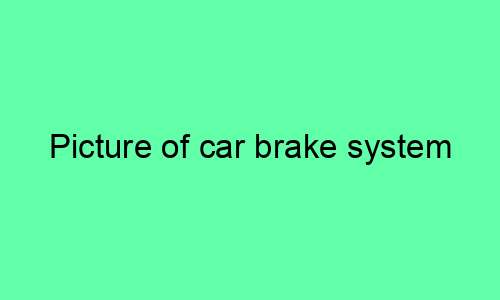## Picture of Car Brake System
The brake system is one of the most important safety features on a car. It allows the driver to slow down or stop the car, and it helps to prevent accidents. The brake system is made up of several components, including the brake pedal, the master cylinder, the brake lines, the brake calipers, and the brake pads.
### Brake Pedal
The brake pedal is the part of the brake system that the driver presses to slow down or stop the car. When the brake pedal is pressed, it sends a signal to the master cylinder.
### Master Cylinder
The master cylinder is the part of the brake system that converts the driver’s input into hydraulic pressure. When the brake pedal is pressed, the master cylinder sends hydraulic pressure through the brake lines to the brake calipers.
### Brake Lines
The brake lines are the part of the brake system that carry the hydraulic pressure from the master cylinder to the brake calipers. The brake lines are made of steel or rubber, and they are routed through the car’s chassis.
### Brake Calipers
The brake calipers are the part of the brake system that apply pressure to the brake pads. The brake calipers are mounted on the wheels, and they use hydraulic pressure to squeeze the brake pads against the brake rotors.
### Brake Pads
The brake pads are the part of the brake system that actually stop the car. The brake pads are made of a friction material, and they are pressed against the brake rotors when the brake calipers are activated. The friction between the brake pads and the brake rotors slows down the car.
## How the Brake System Works
When the driver presses the brake pedal, the master cylinder sends hydraulic pressure through the brake lines to the brake calipers. The brake calipers then use the hydraulic pressure to squeeze the brake pads against the brake rotors. The friction between the brake pads and the brake rotors slows down the car.
The amount of pressure that is applied to the brake pads is determined by how hard the driver presses the brake pedal. The harder the driver presses the brake pedal, the more pressure is applied to the brake pads and the faster the car will slow down.
## Brake System Maintenance
The brake system is a vital part of a car’s safety system, so it is important to keep it in good working order. Regular brake system maintenance can help to prevent problems and ensure that the brake system is always working properly.
Some of the most important brake system maintenance tasks include:
* Checking the brake fluid level
* Inspecting the brake pads
* Inspecting the brake rotors
* Flushing the brake fluid
* Replacing the brake pads and rotors as needed
## Brake System Problems
There are a number of problems that can occur with the brake system. Some of the most common brake system problems include:
* Brake fade: Brake fade occurs when the brake pads overheat and lose their ability to stop the car. Brake fade can be caused by a number of factors, including excessive braking, towing a heavy load, or driving in mountainous areas.
* Brake squeal: Brake squeal is a high-pitched noise that can occur when the brake pads are worn down or contaminated. Brake squeal can also be caused by a problem with the brake calipers or rotors.
* Brake judder: Brake judder is a vibration that can occur when the brake rotors are warped or unevenly worn. Brake judder can also be caused by a problem with the brake calipers or pads.
* Brake failure: Brake failure is a complete loss of braking power. Brake failure can be caused by a number of factors, including a leak in the brake lines, a problem with the master cylinder, or a failure of the brake calipers.
If you experience any of these brake system problems, it is important to have the brake system inspected and repaired by a qualified mechanic as soon as possible.
## Pictures of Car Brake System Components
[Image of a brake pedal]
[Image of a master cylinder]
[Image of brake lines]
[Image of brake calipers]
[Image of brake pads]






